#but they do have a cartilage skeleton!
Explore tagged Tumblr posts
Text

Got it, boss 👍✨
Tell me what you’d like me to draw, I’m bored
#shark au#fun fact: sharks don’t have bones#but they do have a cartilage skeleton!#so while most of the skeleton can’t fossilize besides the jaw and teeth they still have a set of really flexible bones#sans the skeleton#sans the skeleshark#shark sans#undertale#sharktale#newts doodles
45 notes
·
View notes
Note
I’d just like to say, I love that you make jelly Neil have it/its pronouns, even if it’s just because it doesn’t really know what gender is. I myself would love to use it/its as an agender person. but people around me definitely wouldn't understand or just wouldn’t because it’s dehumanizing in their eyes, so having a character I love use those pronouns and people respecting it is really nice for me to see. Thank you so much for doing that, you make me happy every time I see a jelly Neil drawing from you!
🥹 this makes me v happy to hear ahh I get a surge of love for anyone that's replied to it/its→it/he jellyNeil with anything along these lines. Excited to post more mers very soon hehe
#jellyneil knows what it wants and it is flexible ✨#probably in. many ways#considering real jellyfish do not have bones#Neil has what. cartilage skeleton??#definitely a scare sometime about Neil getting stuck in one of its sleeping dens#like that space is TOO small to fit the whole jelly’s body#but Neil wakes up and just. shimmies and pops right out#rested and blissfully unaware of the panic he just caused lmao#jellyfish bones are a source of constant curiosity and also ‘dear god what is wrong with you’ for Aaron#probably 😂#anyway#not art sorry guys#asks#mer au
86 notes
·
View notes
Text
LU Survey 2024 Results
The long awaited results of the survey. Thank you guys for being so patient with me :)
There were 350 responses to the survey this year! Not as many as there were last year, but still impressive. If you want to look at the raw data for this, you can do so here
Demographics





General Questions








Favorites and Least Favorites








Blank Space Question (Select Answers)
I'm so normal about Legend (the biggest lie I've ever told)
WIND BABY WIND OUGH IHGH UUOA I AM SICK FOR HIM MY SKRUNKLE MY OUGHGHHGJUA BELOVED
Remember that fandom is a community! Reach out to each other and learn something new! Give someone a compliment! Ask them a question! Encourage new artists and writers who are still learning! Thank you Mint for doing the survey again, too!
The fact no one has thought of calling Warrior's Zelda, "Areia" hurts me deeply "Hyppolita" even, please, with how much shipping there is between them, people sure are eager to name her after goddesses who have vowed to never have romantic relationships.
I dont think the fandom talks about it but i really love that every single piece of sky clothing is embroidered, because unless skyloft has embroidery machines thats all hand done. Which means either someone he knows makes a lot of them and gives them out freely (i give most of my projects to friends and family) or he would have paid someone for it, which means that either someone on skyloft lives of decorating clothing (and likely other fabrics) or someone just uses it to get some extra money (both are amazing since in the modern day people dont want to pay for handcrafted works what its actually worth)
Shark skeletons are made of cartilage, not bone
It's dangerous to go alone. Take this. 🦆
FOUR SUPREMACY🗣️🗣️🗣️🗣️🔥🔥🔥🔥💚❤️💙💜💪💪💪💪🔛🔝💯💯💯💯💯
No but the Athena/Artemis thing is so real. What’s up with that. Why did we pick Artemis? Why did we do that?
I find it so funny how the fandom has decided to call Dark Link "Dink" because whenever I play a Zelda game I name my character Dink or Dinkus :D I started doing this waaaaay before I knew about LU
Im so excited for Echos of Wisdom! I find it really funny that Nintendo keeps making it harder for JoJo to stick to the plan, I'm pretty sure it's Legend and Fable but I'm not certain any ways Im really happy!
I love how LU is a culmination of so many of my favorite tropes from other fandoms! It’s been really comforting and nostalgic for me despite the fact that I only got into it this year. Especially since so many creators I liked have been getting revealed as problematic, it’s nice to be able to fall back on fictional characters who can’t ruin the lives of real people. :)
#lu survey 2024#linked universe#long post#lu wild#lu time#lu twilight#lu legend#lu warriors#lu hyrule#lu wind#lu four#lu survey#graphs
288 notes
·
View notes
Text
Round 2 - Chordata - Chondrichthyes
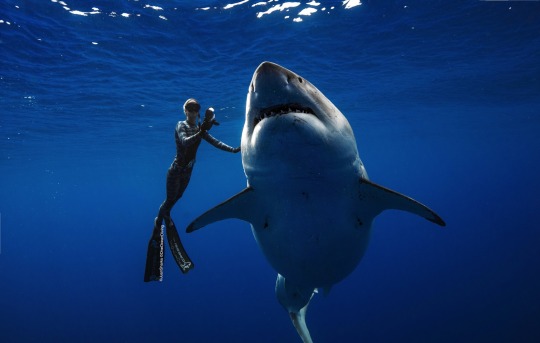
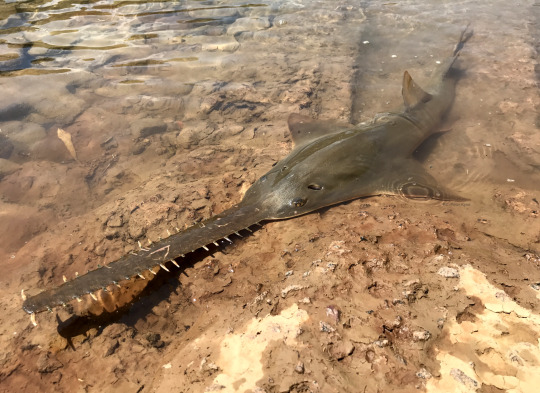
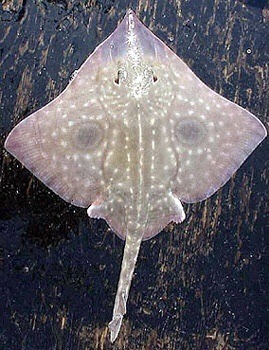
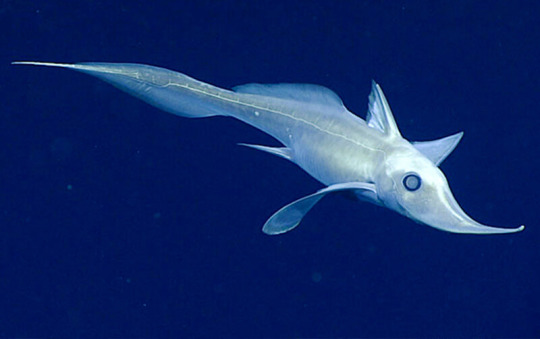
(Sources - 1, 2, 3, 4)
Chondrichthyes is a class of jawed fish, commonly called “cartilaginous fish” due to their skeletons composed mainly of cartilage, making them distinct from all other vertebrates. They are comprised of the superorders Selachimorpha (“Sharks”), Batoidea (“Rays”), and Holocephalimorpha (“Chimaeras”).
Chondrichthyans breath through gills but lack opercula (gill coverings) and swim bladders. They have paired fins, paired nares (nostrils), and placoid (tooth-shaped) scales (except for electric rays, which have loose, soft skin). These placoid scales, also called dermal denticles, provide protection and streamlining, giving the animal’s skin a sandpaper-y feel. All chondrichthyans breathe through five to seven pairs of gills, depending on the species. As a general rule, pelagic species usually must keep swimming to keep oxygenated water moving through their gills, while demersal species can actively pump water in through their spiracles (a small hole or slit behind each eye) and out through their gills. Most larger, pelagic species no longer have spiracles. Chondrichthyans have many sensory organs to perceive the world around them. Their nostrils are attached to powerful olfactory organs. Around their face are a network of electroreceptors called Ampullae of Lorenzini, which allow them to sense electrical fields. Their lateral line has modified epithelial cells which sense motion, vibration, and pressure in the water around them. However, their sound-detecting apparatus has limited range and is typically more powerful at lower frequencies. Some species have electricity-producing organs which can be used for defense and predation. Chondrichthyans have a diverse array of shapes and sizes, ranging from the 10 cm (3.9 in) long, electric Finless Sleeper Ray (Temera hardwickii) to the over 10 m (33 ft) long Whale Shark (Rhincodon typus). All species are carnivores: some predatory, some ambush-hunters, and some filter-feeders. At least one species is omnivorous. Chondrichthyans have internal fertilization and most species give live birth, while some lay eggs. There is no parental care after birth, though some chondrichthyans do guard their eggs.
Chondrichthyans are considered to have evolved from Acanthodians, which appear from the Early Silurian. The first sharks began to evolve in the Devonian Period, though, while often claimed to be relatively unchanged, modern forms did not start appearing until the Early Jurassic.
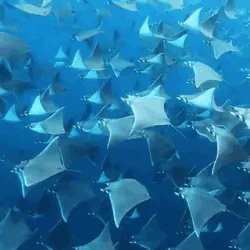
Propaganda under the cut:
Mentioned briefly above, the Bonnethead Shark (Sphyrna tiburo), a small species of hammerhead, is the only shark known to be omnivorous. While it feeds on crustaceans, molluscs, and small fish, it also ingests large amounts of seagrass, which has been found to make up around 62% of gut content mass.
Also mentioned briefly above, Electric Rays (order Torpediniformes) are known for being capable of producing an electric discharge, ranging from 8 to 220 volts, depending on species, used to stun prey and for defense.
There are over 500 different species of sharks, and only a dozen could be considered dangerous to humans. That being said, of those 12, most do not seem to like the taste of human flesh, and bites are usually accidental or exploratory.
Many pelagic chondrichthyans occasionally breach, leaping out of the water. This can be done for hunting purposes, as a mating ritual, to shake off parasites, or even just for fun!
Today, all species of Sawfish (family Pristidae) are critically endangered. However, they were relatively common in the Cretaceous, where they were likely a common food source for Spinosaurus.
(Confusingly, Sawfish are a type of ray while Sawsharks (order Pristiophoriformes) are a type of shark. Sawsharks live in the deep sea and are rarely seen, while sawfish live in coastal and brackish waters.)
Kitefin Sharks (family Dalatiidae) have bioluminescent organs which glow blue in the dark
Chimaeras have a strange pair of teeth in their lower jaw which look like rodent incisors, giving them the common names “ratfish” or “rabbitfish.”
Great White Sharks (Carcharodon carcharias) are regularly hunted by orcas, and when one is confronted by an orca it will generally flee and not return to that area for up to a year.
Manta Rays (genus Mobula) are incredibly smart. They were the first “fish” in the world to pass the “mirror test” (ie show self-awareness by recognizing themselves in a mirror rather than seeing the reflected image as another manta ray). They also have highly-developed long-term memory, form friendships, and play with each other by blowing bubbles and breaching out of the water.
235 notes
·
View notes
Text
Wet Beast Wednesday: hagfish
After taking last week off for mental exhaustion I have returned! And what better way to mark my return than with a shitload (or perhaps a highway load) of slime? Today I'm returning to the agnathan trenches to dredge up one of two living groups of jawless fish. I covered lampreys before, so now it's hagfish time. These ooey gooey critters are both fascinating and kinda gross. Now get ready, because it's time for slime.

(Image: a hagfish in profile. It is a long, brown, eel-like animal with a fin encircling the tail and a small head with no visible eyes or mouth. End ID)
Hagfish, also known as slime eels, are approximately 76 members of the class Myxini. In addition to the living species, hagfish have been preserved in the fossil record, letting us track their evolution through history. Hagfish are one of two living groups of agnathans, commonly known as jawless fish, with the other being the lampreys. As the name suggests, jawless fish are vertebrates without hinged jaws. Way back when bones were the cool new thing in town, agnathans represented the entirety of the vertebrates and were extremely diverse, but the evolution of jawed fish resulted in them getting largely outcompeted, leading to all lineages but the hagfish and lampreys going extinct. Genetic studies indicate that hagfish and lampreys are more closely related to each other than either group is to any other vertebrate. Because they are the only jawless fish left, hagfish and lampreys are of interest to scientists studying the evolution of vertebrates.

(Image: a hagfish coiled up, under orange light. The head is visible, featuring small sensory barbels and a large hole that resembles a mouth but is actually the nostril. End ID)
Hagfish are eel-shaped animals that range in length from a few centimeters to over a meter in the largest species, Eptatretus goliath. They have no scales, flattened tails that bear the only fin, and simple, eyeless heads. The heads bear sensory barbels, a single nostril, and the mouth. The mouth has two pairs of rasping plates that normally sit within the mouth, but can be everted to face outwards. The plates can grab food and pull it into the mouth to be swallowed. Hagfish do not have true eyes, but they do have eyespots that can sense light and dark. Interestingly, their fossil ancestors did appear to have fully-developed eyes that reduced in complexity until the present state. Likewise, ancestral hagfish had a true vertebral column made of cartilage, but modern hagfish only have remnants of their ancestor's vertebrae. Hagfish skin is very loosely connected to the internal body, only attached along the spine and slime glands. This makes the skin very flexible and harder for predators to grab. A third of the blood is contained between the skin and body and is pumped around with the heart as well as a few additional pumps that act as auxiliary hearts. Hagfish have some of the lowest blood pressure of any vertebrate and the highest blood volume to body mass ration of any chordate. Hagfish are also the only vertebrates that do not osmoregulate, meaning they cannot regulate the amount of salt in their bodies. Changes in salinity, especially moving to a lower salinity environment, are very dangerous to hagfish. Hagfish skeletons barely qualify, consisting of only a skull, notochord, and fin rays, all made of cartilage. The gills are internal. Water enters through the mouth and is forced over 5-16 internal gill pouches, then ejected through pores in the side of the body.

(Image: a closeup of a hagfish head with the rasping plates everted. The plates are mounted on pink tissue around the pharynx. there are two plates on either side of the pharyx which look like rows of small, sharp teeth. End ID)
That's all well and good, but you're here because of the slime. The hagfish's main defense is to create lots and lots of slippery slime. The slime helps them slip away from predators. If a fish tries to eat a hagfish, the slime can clog up its gills, forcing the fish to either release the hagfish or suffocate. A common factoid is that a single hagfish can turn a 5-gallon bucket of water into slime in seconds. To produce the slime, the hagfish releases threads made of special proteins into the water from glands on its skin. These proteins react with seawater to create a matrix of trapped water held together by filaments similar to keratin. The slime matrix can expand 10,000 times its original size in 0.4 seconds of exposure to seawater. The slime is quite durable and resistant to breaking and dissolving in water. After sliming, hagfish have been seen wrapping their bodies into an overhand knot and running themselves through the loop to scrape the slime off of themselves. Its possible that the slime also impairs the hagfish's ability to use it's gills and it needs to do the know to get the slime off and breathe again.

(Image: a person reaching into a holding tank full of hagfish and pulling out an armload of thick, viscous, white slime. End ID)
youtube
(Video: a hagfish in the wild demonstrating its knotting behavior. This one is going in the opposite direction usually seen: tail-to-head instead of head-to-tail. End ID)
Hagfish are found in most of the oceans, with range varying based on species. They are benthic animals that rarely swim far above the seafloor. Some species dig burrows to shelter in while others will shelter under rocks and other structures to avoid predators. While lying on the sediment, some hagfish species will coil up while others will lie straight. Hagfish are carnivorous and feed with a combination of hunting and scavenging. A large portion of the hagfish diet consists of polychaete worms and other known prey species include small crustaceans and echinoderms. Some species have been known to hunt burrowing fish, possibly by clogging up the burrows with slime to suffocate the prey. If you've seen a documentary about deep-sea fish you probably know about hagfish scavenging. Using their large nostril and sensitive sense of smell, hagfish can sense carcasses from long distances and are often some of the first scavengers to arrive at a new body. They use their rasping plates to pull bits of meat off of the carcass. A similar behavior to the slime-cleaning knots is seen when scavenging, but in reverse, going from tail to head instead of the other way around. This grants the hagfish additional mechanical advantage, allowing it to rip off larger chunks of food. Hagfish will burrow into larger corpses, possibly to get access to a food source with less competition than the outside of the body. Hagfish act as part of the deep ocean's cleaning crew, consuming corpses before they can decay and release potentially harmful chemicals into the water or act as sources of disease. Unlike any other living chordate, the food a hagfish swallows is encased in a permeable membrane during digestion. Hagfish can also absorbed dissolved nutrients through their skin. Hagfish have a very slow metabolism and ones in captivity have been observed going for up to 7 months between meals.
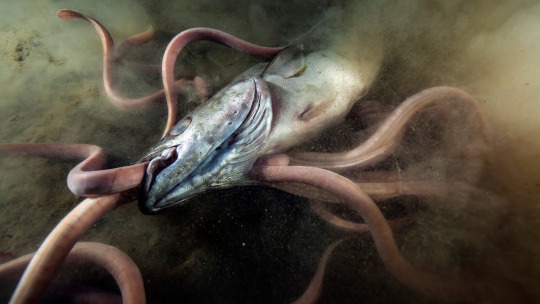
(Image: several hagfish feeing on the body of a fish. The hagfish have their heads on the fish's body and one hagfish is entering the fish's mouth. End ID)
Hagfish reproduction is still something of an enigma as so many of them live in the deep sea, making it difficult to observe them reproducing. It has been observed that females seem to outnumber males, with the exact ration varying depending on species. In some species, the sex ratio is almost even, while in others, there are 7 females to each male. however, it should be noted that females mature sexually faster than males and it has been suggested that this is responsible for the apparent skewed ratio. Hagfish eggs have tufts at the end that cause them to get stuck to each other like velcro. It has been suggested that eggs are laid in clusters possibly in burrows, beneath rocks, or protected with slime. Some species seem to have a mating season and seasonally migrate. Hagfish have only a single ovary or testicle (the latter of which has been described as unusually small by scientists and bullies in the deep-sea locker room) and they have no specialized reproductive tract. Instead, gametes are released into the main body cavity and must find their way to the anus to leave the body. Hagfish embryology is poorly understood, though it has been reported from studies of Eptatretus stoutii (Pacific hagfish) that the eggs can take up to 11 months to hatch. Hagfish have no larval stage, unlike lampreys and bony fish.

(Image: a group of 9 hagfish eggs in a plastic tub. The eggs are ovoid and dark yellow, with tufts of fibers at each end. End ID)
The conservation status and needs of most hagfish species is hard to discern because of the depths they inhabit. Threats to them include bycatch, as hagfish are often caught during deep-sea dredges. It is alos possible the chemical pollutants may be passed to hagfish through scavenging. There is a commercial fishery for hagfish, which is largest off of the west coast of the Americas. Hagfish are eaten as a delicacy in Korea and less commonly eaten in Japan. Most of the hagfish fishery goes to Korean food markets. Hagfish skin is also values as a durable leather and often marketed as "eel leather" or "yuppie skin". Study of the slime and the highly durable threads that produce it indicates they could be used to create very strong materials, similarly to spider silk. Research is currently being undertaken to find uses for hagfish slime and threads.

Once again, these cards show up in my posts (Image the Weird n' Wild Creatures card for hagfish, featuring an exaggerated drawing on a hagfish. End ID)
#wet beast wednesday#hagfish#agnathan#jawless fish#slime#deep sea fish#fishblr#fish#marine biology#biology#zoology#ecology#informative#educational#image described#cw animal death#Youtube
202 notes
·
View notes
Note
how do you think cybertronians would react to us popping our joints? I'd imagine that their body's make noise but I don't imagine hear the Crack or snap that our body's make would be comfortable for them knowing how "squishy" our body's are and to be reminded we're hard inside as well. I'd imagine they'd find it weird we pay people for extreme versions of this to aid in aches or great discomfort some people feel.
Ok so either they know humans have skeletons before the children or after. If they found out after it would be realized after ones of the kinds mentioned breaking a bone to which they ask what’s that.
Everyone was disturbed after a google search
Now if they didn’t know I think they would have assumed we had some kind of hardened exoskeleton. Kind of like cartilage.
They realized humans don’t go squish…they go crunch.
The Decepticons would go from calling humans “meat bags” to “meat sticks”
As for the popping of joints I can imagine Miko either rough housing with bulkhead or one of the bots catching a kid who almost fell by the leg to hear a loud and deafening pop.
Bulkhead: Careful Miko, just because I can catch you if you jump doesn’t mean I will always be there to catch you. *He says as he holds Miko upside down by the leg*
Miko: Come on Bulk, you would never let anything happen to- *Swings back far enough her ankle pops*
Bulkhead: *Immediately drops her before catching her again in his hands and stands in stunned silence*
Miko: Ow Bulkhead! What was that for! *Referring to the drop*
Bulkhead: *Thinking he broke her* Miko! I’m so so sorry. Just hang in there Ratchet will fix you up… *Close to tears*
Miko: What? everyone realized what had happened were like Cybertronian protoforms which they are not. Protoforms are what’s completely under all the armor and there very delicate.
After that debacle Ratchet went to June for more information about bones to which he found out human and cybertronian joint deterioration and disfunction is extremely similar to human conditions such as arthritis.
#I could write forever about this#humans are weird#humans are space orcs#transformers#transformers prime#cybertronian biology#maccadam#miko nakadai#bulkhead#the bots can no longer hear a crunch and not shiver
365 notes
·
View notes
Note
okay triton biology time because I can't stop thinking about it!!!!!
triton are technically a kind of cartilaginous fish, like sharks. instead of bones they have a cartilage based skeleton! they're actually very similar to sharks in general, being pretty much a type of shark that evolved convergently along humans, and ended up looking similar to them. they are constantly growing and losing their sharp teeth, and because of this sometimes they'll wash up on shore and be confused with shark teeth, ending up in jewelry and the like. kinda gross actually now that I think about it. also their hair is not actually hair, being more like a type of weird scale. don't think about it too hard. (their claws are a similar situation) they do have lungs, and gills! they're highly specialized, with the gills being able to close up on land and vice versa. a triton breathing air for the first time would probably be very confused, having previously unused organs be used for the first time. tritons are also distantly related to merfolk, but tritons evolved specifically for deep water while merfolk tend to live in reefs closer to the surface. (that's why merfolk look more like humans!) tritons don't really have "scales", instead having rough skin like sharks do. their diets mostly consist of other fish, with the occasional underwater plant, like specially farmed seaweed. im not quite sure how they cook underwater, but it probably has something to do with thermal vents. this isnt a culture headcanon tho, so i might expand on that later....
tritons also have a somewhat thick layer of blubber directly under their skin to protect them from the freezing temperatures they tend to live in. uhhh yeah that's all i can think of right now!!!! yay fantasy biology :)
!
#yay fantasy biology!!!#I will never forgive charlie for describing tritons as “just humans but Blue” this is cooler I think#jrwi#jrwi riptide
47 notes
·
View notes
Text
giving gillion a tail: bug's thoughts on triton anatomy
yeah im writing a full thing about this okay let me autism lazerbeam in peace.
so the thing with triton anatomy is that one would assume theyre just human anatomy with some extra bits like gills n stuff. and tails, but we'll go into that in a moment. the problem with this is bone structure. not all fish have bones. sharks don't have bones. instead the support structure of their bodies is made of cartilage. which isnt too different, considering parts of human anatomy are made up of cartilage, but it poses some interesting questions. im no scientist, but i am autistic as hell. so im going to pose a couple of options that are fun to rotate.
the most common depiction of tailed tritons (which i myself have drawn) is some variety of fish or shark. this is aesthetically fun bc of the variety within fish and sharks, in terms of colour and shape, that allows you to get funky with it. anatomically speaking, this would probably be achieved via the tailbone being there, like a monkey, but with the muscle and flesh around it being shark or fish-like. this would all lend to a tail that moves side to side, which would lead to an interesting swimming style that probably wouldnt involve much movement of the legs.
the second thought i had for tailed tritons was seals. seals have very short tails, but as mammals they have the same bone structure as humans. due to this, my initial thought was a second set of hips, so the triton bone structure would look like it had four legs, but the second set of legs would be the tail formation. this would lend itself to a tail that moves up and down, which could probably be utilised in tandem with the legs to create a very efficient swimming style.
however, neither of these ideas take into account one very important thing about tritons:
they're amphibious.
oh but bug, they can have human lungs and fish gills with nothing to do with the tail- silence voice i made up purely to disagree! we are not here to do arts and crafts! we are not gluing random creature aspects together with whimsy and magic! this is real science!
so amphibians. frogs and newts and salamanders and the like.
the amphibian life cycle, in most cases, involves eggs being laid in water and larvae being adapted to an aquatic lifestyle. frogs, toads, and salamanders all hatch with external gills, and develops lungs to breathe air as they grow up. amphibians are very adaptable to their environment, and there are many possible variations among individual species purely caused by outside influence and the area they grow up in.
but what does this have to do with tritons and their tails?
tadpoles
unlike most amphibians, frog tadpoles dont look like the adults. frog tadpoles start out fully aquatic, with external gills. as they grow and develop, they get gill pouches to make their gills internal. they have cartilaginous skeletons (which later develop into bone), lateral line systems (found in fish, used to detect movement, vibration, and pressure under water), and large tails. their lungs develop early. their front legs develop first, and then their back legs soon after.
(oh what about axolotls- axolotls dont have lungs. they are functionally the same as salamander larvae but they never get past that developmental stage. theyre amphibians that arent amphibious.)
im running out of steam for this post but basically what im trying to say is that triton are froglets. this would also make sense for the fact that triton have webbed hands and feet. frogs do too so it would be implemented into the swimming style. bone structure is a whole nother things, especially since both 'mordenkainen presents: monsters of the multiverse' and 'volos guide to monsters' are cowards whos triton designs are just blue people. but working from 'mythic odysseys of theros' designs, who have at least a little bit of flare, i think it's safe to assume that their bones are a little funky. some fun mix of bone and cartilage to have those interesting shapes.
all that being said, i am a big supporter of doing whatever you want forever. i am also just a massive nerd and like to think way too hard about these things.
(shoutout to my dad for assistance with bouncing ideas around, and for being the one to suggest the tadpole thing.)
#dnd#d&d#d&d triton#jrwi#riptide#jrwi riptide#gillion tidestrider#gillion jrwi#jrwi gillion#i did not proofread this at all godbless
79 notes
·
View notes
Note
do you have a post on your taur anatomy ideas, id love to see that
We have MANY thoughts on anatomy for taurs and you just gave us a perfect reason to ramble xD
Our skinless friend here is an elk, but in general taurs all share one common ancestor which split first into Carnivora (all carnivores) and Euungulata (hooved herbivores)*. There are differences in anatomy based on species and size but GENERALLY speaking they have a fair amount of similarities.
(Small note: this is a recent change, which will ALSO have it's own post)

Starting with the skeleton. If you can't read my chicken scratch;
1) "For horned/antlered taurs, head is slightly extended". This has a to do with the weight of the antlers and horns, mostly for strutctural integrity of the skull.

2) The ear holes are located higher than a humans, which is what the blue writing "(also higher) Ears rotate! Limited movement"
3) "Longer necks with thicker bones" is in general for all taurs.
4) Not written, but the ribcage is wider and longer than a humans, to house VERY big lungs and a heart. In a previous post we talked about taurs on Ithiir having long long lungs...
5) "Very soft cartilage ribs" and plates are for extra protection of the esophagus and arteries that flow here. As well as the ends of the freakistly long lungs.
6) "fake belly button!" Has to do with the above point: the cartilage ribs end, causing a divot for most body types (not all). The umbilical cord connects on the lower half of the taurs.
7) "Thick sternum for extra muscle connections"
8) "All muscles and Tendons" pointing to the back of the spine on the upper torso is mostly a note for me. There aren't any organs here, and these tendons work like a draw bridge that is defaulted to remain upright instead of down. It's a big complex system of pullies and ropes basically.
9) "Like a ball joint" and top view of connecting spinal, small nubs, not wide club shape" refer to the seven extra vertebrae of the torso. They work like an animal's neck combined with a human lower back. They are EXTREMELY flexible, since all taurs are about as flexible as a human rather than their animal counterparts (excluding cats and such, they are exactly that flexible). We just call this area "the mid back".
10) "Real belly button =)" like it says, lol
There are... SO many more thoughts than this, we will probably reblog this with a part 2 for organ placement. :)
#sotcc#siege of the crystal citadel#art by okami#visuals#original story#centaur#elk#anatomy#questions and answers
74 notes
·
View notes
Note
PLEASE TALK MORE ABOUT MK DEMON BEAST FORM.... on my hands and knees rn 🙏
Ok so pretty much this is like his “true form” this is the potential that nightmare gave him after kidnapping him and experimenting on him as a baby, so before I start explaining the anatomy and junk here is what the true form looks like yeah

So I’ll explain a little bit, he has two pairs of wings, one attached to his arms and the other grows to an enormous size which allows him to fly around extremely fast
In comparison to normal Mk, this is what they look like side by side

In order for this to be possible, nightmare had to alter his anatomy to allow for him to stretch to this size, so here’s some stuff to explain dat


So in comparison to a normal skeleton, Mk has two extra humerus bones, and two extra femur bones
Basically what they will do when he begins transforming is they will dislocate and the extra bones will pop into the ball joint socket and pop into the other bones to create a new joint and making him super tall. Another thing is his spine is cushioned with a BUUUNCH of cartilage that allows for his spine to be stretched and give him more height as well But what is the point of all this?? Like why would nightmare go to this extent instead of just giving Mk some crazy power, here’s why
The True form is supposed to be nightmares way of mocking Mk while still using him as a pawn here’s an example, Mk is already insecure about his body, his height, and the wing mutation that he has, so nightmare uses this to his advantage


With true form Mk, nightmare mocks him by exposing the parts that he doesn’t want people to see, or making a caricature out of his desires. Since Mk is already insecure about his body, nightmares exposes his stomach, and also gives him height, but in a way that makes him look like a beast. He amplifies his wings to show everyone who he truly is, and completely changes his face to look like a monster
The true form happens to Mk three times
The first time is when nightmare uses him to ambush the GSA during the first war, and this is also when he loses his vision (Mk rips his own eyes out)
The second time happens in Meta knights revenge, when he’s fighting Kirby and chasing him out
And the third time happens in Star allies when he gets controlled by the Jamba heart
So yeah this is what true form Mk looks like, I’m open to any questions you guys have and yeah!
Here’s how the transformation looks like too

I kind of laughed
OK GOODNIGHT GUYS YALL ARE WELCOME TO ASK STUFF AND YEAH!
PLEASE ASK QUESTIONS IF YOU HAVE ANY I WILL HIT THE GRIDDY IF YOU DO 🤑🤑🤑🤑🤑🤑🤑
#kirby#kirby series#meta knight#kirby gijinka#kirby headcanon#kirby gijinka au#kirby au#meta knight gijinka
29 notes
·
View notes
Note

what are your thoughts on inklings/octolings having bones? (source: https://twitter.com/V0zkoZo/status/1774212478500540539?t=vTVm4GhkaKy3_VYzaa7zEA&s=19)
They've had "bones" since the first game (very obviously with Captain Cuttlefish), also have knees and elbow joints, and in the Splatoon 3 inkling models even the collarbones are quite prominent if i remember that right. So like them having bones in the models is nothing new, I think it's mainly done for the simplicity of having a human-shaped character not be extremely uncanny if it didn't actually follow the general shape and likeness of a human. Hell, in the "realistic" art style they use in some places in the game, Inklings are literally drawn to look just like humans except with tentacle hair, so the intent seems to be that they register as "human" moreso than "weird humanoid squid" to the player.
It's been stated countless times in the game itself that Inklings do NOT have bones, and while that doesn't technically mean they couldn't have some other type of support structure that's just also identical to a human skeleton because why not, I don't like the cartilage skeleton approach either because them having a solid support structure as a whole feels like it STILL goes against the whole point of the inkfish being boneless and especially against them being very flexible and malleable and literally changing shape completely. I think, personally, the reason they Have Bones in the general character design is just because that's WAY EASIER to animate, draw and deal with and still have widespread appeal while making the Inklings easily register as humanoid when they have basically the exact same anatomy. which they shouldn't. So basically TL;DR they don't have bones, i've accepted that they will forever keep being depicted with bones despite them not having bones, and I don't care lol
also, naked dedf1sh flashbang
79 notes
·
View notes
Note
Okay so Galkifreyans are physically and socially mature at different ages, which is similar to humans, but are there any other significant similarities or differences during adolescence? Like is puberty physically and emotionally awkward? Is there teenage moodiness and angst? Etc.
What are Gallifreyan teenagers like?
Gallifreyan teenagers have a much longer adolescence than humans (around 16-100), so they don't get to skip the fun bit of growing up.
💡 Physical Changes
Puberty: Gallifreyans go through a version of puberty involving not just physical changes but also psychic and temporal senses. The physical stuff is largely similar to the human transition, but as far as psychic and temporal stuff, well, more on that below.
Acne Happens: Yes, even on Gallifrey, acne is a thing.
Durability: Their skeletons are still transitioning from cartilage to bone, making them surprisingly durable and less likely to break.
Eating Machines: Gallifreyan teens eat as much as or more than human teens.
Sleepyheads: Gallifreyan teens sleep more than their adult counterparts and even more than humans, in fact.
Cold Sensitivity: Surprisingly, Gallifreyan teens are less resistant to the cold than adults, so layer them up in that cute little duffel coat they hate.
Libido: Yes, while Gallifreyan society emphasises control and decorum, uninhibited teens do have a libido.
🔮 Psychic & Temporal Puberty
Psychic Whirlwinds: Teens develop their psychic abilities during this period. Telepathic oversharing, like accidentally broadcasting your thoughts to your bully, is possible.
Time Sense Chaos: As their connection to time strengthens, they might get glimpses of the future or past without warning.
Social Amplification: Academy training enhances their psychic connections to peers and society, making it painfully obvious to everyone if they're falling behind.
😒 Teenage Moodiness and Angst
While we have no frame of reference beyond a few individuals who were definitely angsty, we can be very sure that with all this going on, a bit of moodiness and angst would be a given, but that's up to the individual.
⚠️ The Big No-No: Regeneration
Teenagers can regenerate, but it's extremely dangerous. Their developing biology makes the process unpredictable and even life-threatening, which is why Gallifreyans shouldn't be regenerating until at least First Maturation (around 200).
🏫 So ...
Gallifreyan teens may hail from a race of near-immortal beings, but their adolescent years are surprisingly relatable. The only difference is that while human teens worry about spots before prom, Gallifreyan teens stress over passing their trans-temporal ethics exams. Same energy, though.
Related:
💬|🧸🏫What were the Doctor and the Master’s school days like?: Overview of the general structure of Gallifreyan education, and how badly these two handled it.
💬|🍼👶What would a Human/Gallifreyan child be like?: Developmental expectations of a hybrid.
💬|🧸🏫What are young Gallifreyans/Time Tots taught?: Detailing what the kids of Gallifrey are taught.
Hope that helped! 😃
Any purple text is educated guesswork or theoretical. More content ... →📫Got a question? | 📚Complete list of Q+A and factoids →😆Jokes |🩻Biology |🗨️Language |🕰️Throwbacks |🤓Facts →🫀Gallifreyan Anatomy and Physiology Guide (pending) →⚕️Gallifreyan Emergency Medicine Guides →📝Source list (WIP) →📜Masterpost If you're finding your happy place in this part of the internet, feel free to buy a coffee to help keep our exhausted human conscious. She works full-time in medicine and is so very tired😴
#doctor who#gil#gallifrey institute for learning#dr who#dw eu#gallifrey#gil biology#gallifreyans#ask answered#gallifreyan biology#whoniverse#time lord biology
23 notes
·
View notes
Text
Precursor Anatomy Pt. 2
Continuing some more things with my headcanons on Precursors, here is a part 2 to the anatomy bit I had previously posted months ago!
Part 1 can be found here!
Again, these are just headcanons for myself and my main AU, which is all meant for fun!
With that said, here we go to start with the skeleton once again!
The Skeleton:
Picking up from part 1 where we briefly discussed the bones of the Precursor species, we were only given a view of the skull and a few notes. Here, now, we have a full skeleton to look to!

Just as previously stated, the bones are stained a teal bluish gray in color due to the rich, dark blue blood that flows through their bodies. It also stands tall in its stature, as most individuals average a height of above 16 feet. However smaller individuals have been documented and seen as well as taller individuals as well being close to 18 feet in height.
Their skeletons bear a striking and haunting resemblance to that of our own, being eerily similar in structure and stance. However, as previously stated, there are a few keen differences that do pop out to the eyes. Aside from the height and coloration of the skeleton, some parts of the bones have extra ligaments attached to them that are made of a cartilage like material. These ligaments are mostly attached to specific parts of the body that allow for Precursors to be flexible and agile when they need to be, mostly around the arms, hips, neck, and chest.
The elbows, wrists, and heels also possess defensive pikes to aid Precursors in a natural form of protection for self-defense. These pikes naturally form from the bones and harden as they break out of the skin and take on a darker color. Their spines are also lined with special pikes known as nerve pikes, which allow Precursor nervous systems to properly function. This area, much like the back of their heads, are extremely sensitive to touch.
A final note of detail also falls on the hips, being wide and nearly identical to female human hips, indicating they do carry their young within and give birth similarly to humans. This is a clear indicator to Precursors being an intersex species.
The Body:
Next comes the physical body frame of the Precursor, which has been showcased many times in numerous posts before. But with the help of En, we can get a better look and idea of the Precursor body by glance of his frame.

Beyond the skeleton lies a body that is shrouded in pale white skin lined with dark stripes and markings alike that paint the most sensitive parts of the frame. These dark markings are an outside liner of the nervous system that lines their bodies while also helping to regulate warmth/heat throughout their bodies. However, over time and the course of evolution, these markings have begun to fade with time though the purpose they hold still remains just the same.
As shown below, with a repeat post of the height references over time, the evolution of their bodies is shown throughout the different time periods.

As time goes on and evolution stays its course, Precursors of the modern era have grown taller and somewhat lankier to fit into their newfound environment in their great worldships orbiting in space. Their claws have grown longer and sharper, their bodies more flexible and taller, their tendrils longer to better aid them in feeling out their surroundings and reading the environment better.
The Tongue:
A rather short passage here, but an interesting and quick note to be made about Precursor tongues is that they possess some rather long, giraffe-like tongues in nature.

While hardly ever seen out in the open, as it is considered rude and impolite to show one's tongue in the public in Precursor culture, their tongues are considered to be quite long and strong. These powerful muscles actually help them in extra grooming methods such as keeping one's eyes clear of debris or adding a protective layer of saliva to keep them cool in hot places. It also aids them in getting hard to reach food that is out of their reach when out and about living off newfound environments.
This long, prehensile tongue sits comfortably within a pouch in their jaws.
The Teeth:
And now comes the last bit of notes that can be offered for the moment, Precursor teeth!
While briefly touched upon in the last post, it is important to look upon the teeth of a Precursor as part of their anatomy. These teeth, while some would think are dull and small like a human's, are quite large and powerful when seen.

Adult Precursors have long and sharp canines that are nearly identical to that of a chimp. And while their bites are not powerful enough to crush bone, they are dangerous enough to sever flesh and pull them from the bodies of unfortunate individuals daring enough to provoke them.
Despite such sharp canines, however, the rest of their teeth prove Precursors to have a varied diet of both meats, fruits, and vegetables that are easily broken down with these powerful teeth.
These teeth are also used as displays of threat to further emphasize a Precursor's viewing of undesirable individuals. This is usually accompanied by their skin darkening and the flare of nerve lights lining their faces and necks.

However, these powerful canines are only found in adult Precursors. Children under the equivalent age of 14 do not have these canines but instead blunt milk teeth.

As soon as a child hits the age of 14 (the equivalent of it), their canines will begin to grow in. This process is considered to be extremely stressful and painful to the child as it causes heavy and chronic headaches that last about a month. These headaches are almost akin to a heavy migraine. Many parents usually try to help their children through this painful moment with medicines and teas to ease their pain.
---
This now concludes part 2 of the headcanons on anatomy! Again, these are just my own personal thoughts and headcanons for my AU and more will come soon! c:
36 notes
·
View notes
Text
Monster Spotlight: Thin Men
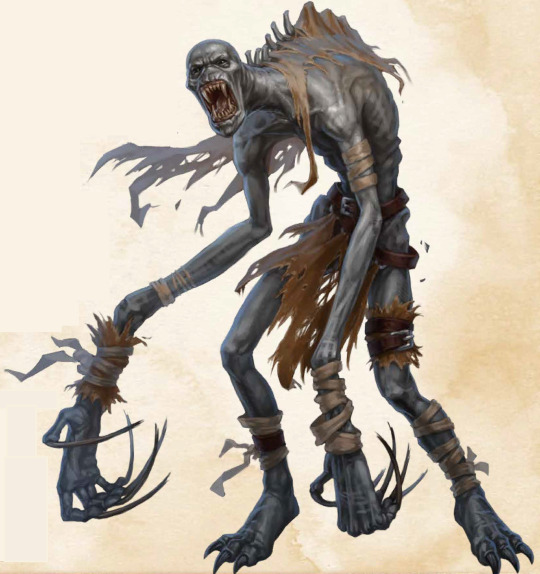
CR 4
Chaotic Neutral Medium Fey
The Inner Sea Bestiary, pg. 52
These uncanny Fey stalk through the cane fields of the Island of Nuat off the coast of Rahadoum, so good at masking their own presence that they’re widely believed to be myths... up until a farmer goes missing with no explanation. Though capable of subsisting on a diet of root vegetables, insect grubs, and whatever vermin they can catch, Thin Men sometimes hunger for a grander fare, stalking and killing livestock, pets... and even whole humans for sustenance. Despite this horrid habit and their ghoulish appearance, though, they do not perform these acts with any malevolence, and in most cases avoid killing humans unless they’re starving. Many of the fatalities owed to them are because of an unfortunate fairy quirk: Thin Men, like many Fey who’ve grown alongside mankind, seem to have an irresistible compulsion to try and remain hidden and out of sight, though unlike kinder House Spirits and Brownies who simply abandon their homes if acknowledged too much, Thin Men respond to people looking at them for too long with startling hostility.
And, well, when the deed is already done, it’d be a waste to just leave this meat laying around, wouldn’t it?
For most citizens living alongside Thin Men, though, they do not have to worry about accidentally offending their homicidal neighbors. These fey are very, very good at staying hidden, spending hours of their days underground hunting for the bugs, roots, and vermin they normally subsist on, their intimidating claws actually for burrowing rather than attacking, and they can tunnel easily through 20ft of earth a round. They’re actually almost entirely boneless, their skeleton formed of sections of incredibly flexible cartilage and further aided by a surplus of joints throughout their body, allowing them to cram themselves into spaces that would normally only allow rabbits (which are likely rare and prized treats for them). They’re not dedicated subterranean hunters, though, lacking any senses which would allow them to track prey through the soil and instead relying on above-ground evidence of food and then digging downwards.
Even when not slithering underground Thin Men are hard to see. They have a +17 to Stealth and move stealthily at every opportunity, but in their natural habitat among the cane fields, they’re effectively impossible to spot as their Stealth shoots all the way up to +25, their instincts causing them to unconsciously sway their bodies with the cane as it moves and dart into the shadows cast by the plants. Even in cane farms this instinct carries them well, with many farmers unknowingly harboring entire colonies of Thin Men among their crops, never quite realizing why they feel watched every time they’re out and about. Since they were on the isle of Nuat first, most farmers can shrug off the feeling and learn to silently thank the fey for their work in keeping pests from nibbling at their crops, but ‘silently’ is the operative word here. Never acknowledge them, lest you draw their wrath.
An offended or starving Thin Man, or one who was caught out of their stealth, attacks swiftly and violently with a Claw-Claw-Bite. Their bite deals 1d6+4 damage, and their dirt-crusted claws 1d4+4, but those claws leave gaping wounds in their wake which deal 1d4 bleed damage a round every round until the victim receives some healing. Despite being Medium, a Thin Man’s extreme flexibility allows it a 10ft reach with its claw attacks, allowing them to control wider swaths of their home fields and attack viciously without harming the plants they hide among. Though the prospect of them appearing from seemingly nowhere to attack is scary enough, the idea of one simply lashing out with a claw in retribution before returning to hiding is just as bad; a victim might not even realize what they saw, thinking it some sharpened branch or similar which stuck them, stumbling helplessly through endless fields of cane as they slowly succumb to bloodloss, never knowing if they’re going to be found as the wind blows through the cane again and reveals a half-dozen stalks that don’t bend in any direction but towards their body as they slowly lose consciousness.
Spooky stuff! And it’s easy to make players paranoid of these creatures with one simple trick: Their ability to Vanish into thin air once per day. As a move action while benefiting from any level of concealment, a Thin Man can seemingly fade from sight by contorting its body into the blind spots of any creature looking towards them. This isn’t invisibility, it’s better, as the Thin Men gain a flat +20 to Stealth checks (for a total of +37 outside cane fields and +45 within them) and can hide in plain sight for up to seven rounds. Whereas normal invisibility can be thwarted by solutions magical and mundane, the Thin Man’s Vanish cannot be beaten by anything but an astronomical Perception check, the effect only breaking if the fey directly attacks another creature. Otherwise, the Thin Man is essentially gone, an effect which may trick players into believing the creatures can teleport as soon as they’re out of sight.
With their burrowing prowess, high Stealth, and ability to simply choose not to be seen once a day, the Thin Men are excellent tools for instilling paranoia on players venturing out into the wilderness to get rid of what they believe may be a simple quest objective. Though Thin Men go down easily once cornered (their sole immunity is to poison, and their AC and HP are merely okay), just killing one doesn’t mean their threat is over. There is, after all, a non-insignificant chance that the Thin Men presented here represent the least skilled and most reckless of their kind, while the rest sit invisibly in the old cane fields, impossible to ever see. There’s a very real possibility that the Thin Men of Nuat are the only ones that have been conclusively proven to exist, that there may be others adapted to different conditions and imitating different plants--reeds, wheat, corn, even the thin saplings in the forests around every settlement--that have gone undiscovered.
There’s a chance that Thin Men might be everywhere.
You can read more about them here.
54 notes
·
View notes
Text
Round 1 - Phylum Chordata

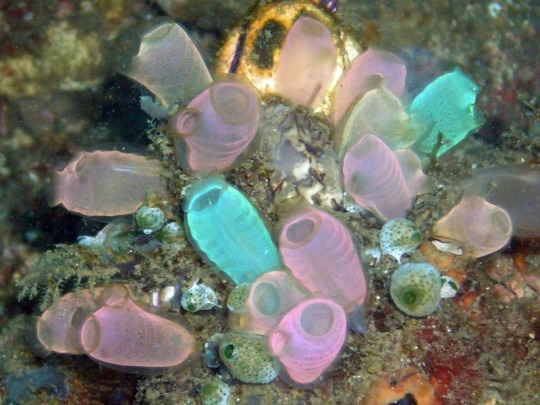

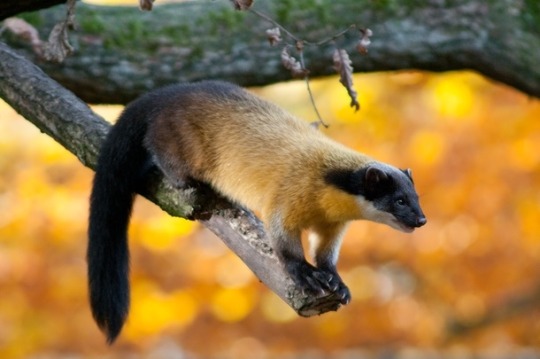
(Sources - 1, 2, 3, 4)
Chordata is a phylum consisting of bilaterial animals that have, at at least some point in their development, a notochord and a dorsal nerve chord. It consists of the Cephalochordates (lancelets), Tunicates (sea squirts, salps, and larvaceans), and Vertebrates.
Vertebrates replace their notochord with a spine in early development, while tunicates only retain their notochord and dorsal nerve chord during their larval stage. Vertebrates and tunicates are more closely related to each other than they are to lancelets (first image), which are fish-shaped filter-feeders. They typically inhabit the sea floor, burrowing the bottom halves of their bodies into soft substrate. They have gill slits, but these are used for feeding on plankton rather than respiration. They have light-sensing organs, and one frontal eye. They do not have hearts or brains. They have two sexes, though hermaphroditism has been observed, as well as at least one instance of a lab-raised female transforming into a male. They breed by releasing eggs and sperm into the water synchronously. Larvae are asymmetrical, with the mouth and anus on the left side, and the gill slits on the right side.
Most tunicates are also filter-feeders, ranging from the sessile, sponge-like sea quirts (second image) to the planktonic salps. All tunicates start life as free-swimming, tadpole-like larvae with rudimentary brains and light sensors, before they metamorphize into their adult forms. Meanwhile, the larvaceans retain tadpole-like shapes and active swimming all their lives. Salps move by contracting, similarly to jellyfish, straining phytoplankton from the water. They have a complex life cycle, in which one generation of solitary individuals reproduces asexually by producing a chain of tens to hundreds of individuals, which are released from the parent at a small size. The next generation consists of a colony of salps (called blastozooids) remaining attached together while swimming, feeding, and growing. This generation reproduces sexually, first maturing as females and later transforming into males. Older chains of male blastozooids will fertilize the eggs of younger female chains. Growing embryos are called oozooids, and eventually detach from their parent blastozoids, to feed and grow as the next solitary, asexual generation. Meanwhile, some species of sea squirt live as solitary individuals, while others replicate by budding and become colonies of zooids. They are filter feeders with two tubular openings, called siphons, through which they draw in and expel water.
The most simple vertebrates are hagfish, which have a skull but no vertebral column. They are marine predators and scavengers who can defend themselves against larger predators by releasing copious amounts of slime from mucous glands in their skin.
Lampreys have an ambiguous position in the vertebrate tree of life, bearing a complete braincase and rudimentary vertebrae. They spend the majority of their life as filter-feeders. A small handful of species are known to be carnivorous as adults, boring into other fish to consume flesh and/or blood.
Chondrichthyes (“cartilaginous fish”) have skeletons composed mainly of cartilage. They breath through gills but lack opercula (gill coverings). They have internal fertilization and some species lay eggs while others give live birth. Chondrichthyans have tooth-like scales called dermal denticles or placoid scales. These usually provide protection, and in most cases, streamlining. Today, chondrichthyans are represented by sharks, rays, skates, sawfish, and chimaeras. All species are carnivores, though at least one species is omnivorous.
The majority of chordate species are Actinopterygians (“Ray-finned Fishes”). They are so called because of their lightly built fins made of skin webbings supported by thin bony spines. They are the most abundant free-swimming aquatic animals and can be found almost anywhere there is water. They come in a vast majority of sizes, shapes, colors, and behaviors, from the 8 mm (0.3 in) long Paedocypris to the 11 m (36 ft) long Giant Oarfish (Regalecus glesne). In most actinopterygians, males and females exist and reproduce through external fertilization. However, some species utilize sequential hermaphroditism, in which they start life as females and convert to males at some point. In a few species, they start life as males and convert to females. Some species give live birth, and some species self-fertilise. Actinopterygians have feeding strategies ranging from predatory to grazing to filter-feeding.
And lastly, the Sarcopterygians (“Lobe-finned Fishes”), named for the prominent muscular limb buds (lobes) within their fins. They are represented by the coelacanths, lungfish, and tetrapods. The vast majority of the rest of chordate species are tetrapods, a terrestrial clade of sarcopterygians who evolved air-breathing using lungs. They are highly diverse, with a large variety of forms, biological strategies, and ecological roles. Along with arthropods, they are the only other group of animals to have adapted to life in dry environments, and the majority of them live on land.
Chordata is one of the largest phyla of animals when it comes to species and is also one of the oldest phyla, known from as early as the Cambrian explosion.

Propaganda under the cut:
Lancelets naturally express green fluorescent proteins. They may use this green fluorescence to attract plankton towards their mouths.
Mentioned briefly above, the Bonnethead Shark (Sphyrna tiburo), a small species of hammerhead, is the only shark known to be omnivorous. While it feeds on crustaceans, molluscs, and small fish, it also ingests large amounts of seagrass, which has been found to make up around 62% of gut content mass.
The Mangrove Rivulus (Kryptolebias marmoratus), a species of killifish, mostly breeds by self-fertilization and can survive for about two months on land. Males are rare, and can only hatch from eggs kept below 19 °C (66 °F).
The largest chordate is the Blue Whale (Balaenoptera musculus), which can reach a maximum confirmed length of 29.9 m (98 ft) and weigh up to 196 long tons; 219 short tons). While it’s not the longest, it is the largest animal known to have ever existed.
At least one of your favorite animals is probably in this phylum. Most of the animals people keep as pets are in this phylum. We are in this phylum.
I am tired, and there is no way I can write enough propaganda for this poll, so I trust you can supply your own.
#round 1#animal polls#i was lookin for a gif and I just searched Bird and Gritty was in there for some reason#and I had to be like I Mean??#I GUESS??!?!#he’s a chordate???!??#anyway WE DID IT GUYS WE MADE IT THROUGH ALL THE PHYLA
166 notes
·
View notes
Text
Wet Beast Wednesday: whale shark
So I may have committed a cardinal sin last week because I didn't realize it was shark week and instead of a shark, I covered hagfish. This was clearly a terrible oversight and to make up for it, I'm going to talk about the biggest shark of all: the mighty whale shark.
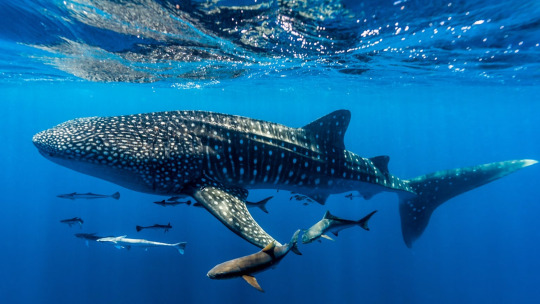
(Image: a whale shark seen from the side. It is a very large shark with a flattened head and three ridges running down its side. The skin in grey and covered in white spots. Smaller sharks and remoras are swimming alongside it. End ID)
Whale sharks (Rhincodon typus) are carpet sharks, meaning they are members of the order Orectolobiformes. The carpet sharks most people are familiar with are the wobbegongs, who are ventrally flattened sharks they typically stick near the seafloor, but Orectolobiformes is a pretty diverse clade containing a large variety of sharks with diverse body plans. Whale sharks are the only living member of the family Rhinocodontidae, making them effectively cousins of the wobbegongs. While there is only one living species of whale shark, we know of another few in the fossil record and there were likely more extinct species and relatives that we don't know about. Because shark skeletons are made of cartilage, they rarely fossilize, leaving only their teeth as fossils. Whale sharks have very tiny teeth and smaller things are less likely to fossilize than large things. Add in that fossilization is very rare and it's very possible there were whale sharks and other similar things in the past we will never know about because they never fossilized.
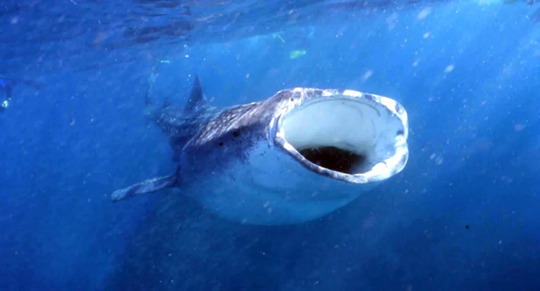
(Image: a whale shark seen from the front. Its mouth is open, very wide, and apparently toothless. End ID)
Whale sharks are the largest living sharks and the largest living animals that aren't whales. Whale sharks can reach an average adult size of 14.5 meters (48 ft) and 18,600 kg (41,000 lbs), with males being larger. The largest whale shark on record was measured to be 18.8 m (62 ft). Whale sharks have broad, flattened heads and unlike most sharks, their mouths are on the front of the head instead of beneath the snout. The mouth can be over 2 meters across in an adult and is lined with approximately 300 rows of tiny teeth. These teeth are vestigial and do not play a role in feeding. Instead, the shark uses a structure at the back of the mouth composed of 20 fleshy pads that are coated with a thin mesh and held in place with connective tissue. More on feeding below. Whale sharks are grey in color, with white bellies and white spots covering the body. Each whale shark has a unique pattern of spots that scientists can use for identification. The spots will reappear in areas where damaged skin has healed instead of being scarred over. Whale sharks also have some regenerative ability, being able to recover from major wounds and possibly regrow sections of lost fin. Each side of the body has three long ridges that may help with streamlining.
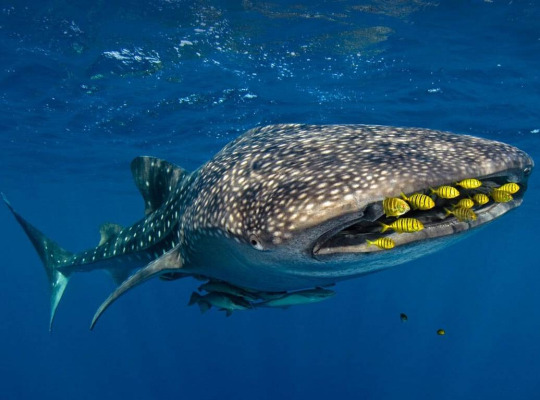
(Image: a whale shark seen form the front with its mouth closed. There are remoras attached to its underbelly and a group of small yellow fish with black stripes swimming near the mouth, possibly acting as cleaner fish. End ID)
Whale shark skin can be up to 15 cm thick and is covered with tiny, tooth-like scales called dermal denticles. Having tiny teeth where bony fish have scales is normal for sharks. What is not normal is having them on your eyes, but the whale shark does anyway. Let me repeat: whale sharks have teeth on their eyeballs. I like body horror and I'm creeped out by that. The eyes can be retracted into the head and these two adaptations are believed to protect the eyes from predators and parasites. Another adaptations the eyes (which, again, HAVE TEETH ON THEM) have is a mutated version of rhodopsin, the pigment the rod sells of the yes use to see. this mutation makes the eyes good at seeing blue light, but the rhodopsin becomes unstable in warm temperatures. In humans, this mutation leads to a degenerative eye condition that can result in blindness. Whale sharks have a solution, though. When in warm, shallow water, the pigment can be turned off to keep the eyes from degenerating. When the shark dives to deep water, the pigment is reactivated, granting the shark better vision as blue light is the most common in the deep sea.
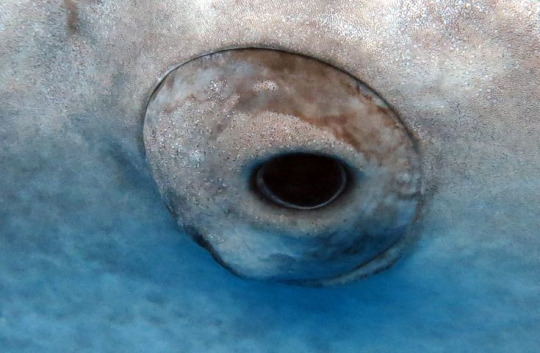
(Image: a close-up of a whale shark eye. It is a small, black, lidless eyeball surrounded by gray skin. End ID)
While whale sharks are huge, they aren't hunters. They are one of three living species of filter-feeding shark, the others being the basking shark (which I covered previously) and the awesomely-named megamouth shark. The majority of a whale shark's diet consists of plankton: primarily copepods, krill, eggs and larvae, and small fish, squid, and jellyfish. The shark can feed either by ram feeding (swimming forward with the mouth open) or creating suction to draw water into the mouth. The mouth is shaped like a funnel and forces water through the filtration pads. The pads, which likely evolved from gill rakers, capture food particles, which are then swallowed as the water is forced out through the gills. The filtration pads are extremely efficient and resistant to being clogged up with debris, though whale sharks have been observed performing a coughing-like behavior that is speculated to help clean the pads. Whale sharks spend up to 8 hours a day near the surface of the ocean, feeding on an estimated 2.7 kg (6 lbs) of plankton per hour.
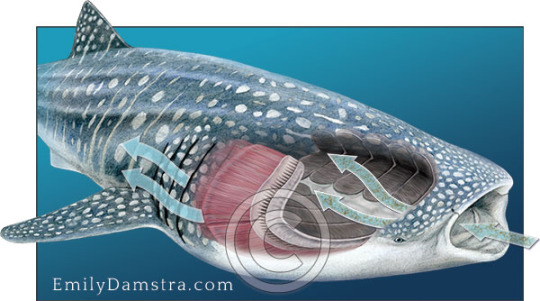
(Image: an artistic diagram of the feeding pads and gills of a whale shark and how water flows through the mouth and out the gills. Source: EmilyDamstra.com. End ID)
Whale sharks live in temperate and tropical oceans worldwide and can be found in both the open ocean and coastal regions. They are gentle giants who swim slowly and bask at the surface of the ocean, not threatening anything bigger than a sardine. While they spend a lot of time at the surface, whale sharks periodically dive in search of food. Most of these dives are less than 200 meters (660 ft) deep, but they will occasionally dive over 500 m (1,600 ft) deep. The deepest recorded dive reached 1,928 m (6,325 ft), the deepest recorded dive of any fish. Whale sharks are known to practice different feeding behavior based on available food in their region. There are two subpopulations of whale shark based on location: the Atlantic and Indo-Pacific populations. 75% of the whale shark population lives in the Indo-Pacific. Whale sharks seasonally migrate following warm waters and food and may also migrate to mate. Multiple places around the world host seasonal gatherings of whale shark, making them to best place to reliably see them.

(Image: a whale shark from the side, swimming with its mouth open. Other fish can be seen in the background. End ID)
Not much is known about Whale shark mating. It has only been seen a few times in Saint Helena Island in the Atlantic and off the coast of Australia. Mating likely occurs during the seasonal aggregations. Female whale sharks are believed to travel to regional pupping grounds to give birth, but where exactly these are is an open question as juvenile whale sharks are rarely seen. The youngest whale shark ever observed was discovered having been captured and tied to a stake on a beach in Pilar, the Philippines. It was measured at 38 cm (15 in) and was released after being measured. This discovery likely means there is a pupping ground in the area. Whale sharks are ovoviviparous, meaning their eggs hatch internally and the young are born live. Whale shark females are believed to be able to reserve sperm and impregnate themselves repeatedly between matings, rather than bearing all their young at once. It is not clear how long it takes whale sharks to mature or how long they can live, though some estimates put them at sexually mature at around 25 years old and with a maximum lifespan between 50 and 150 years. It is estimated that only 10% of whale sharks live long enough to reach sexual maturity. Adult whale sharks have no natural predators.

(Image: a baby whale shark that was rescued from a gill net in India. It looks like a smaller version of the adult, but with a proportionately larger head. A human (out of frame) is holding it just above the water. ENd ID)
Whale sharks are classified as endangered by the IUCN. They are threatened by fishing, poaching, bycatch, and boat strikes. Whale sharks are hunted for their skin, liver oil, and meat, though countries worldwide are increasingly regulating or banning whale shark hunting. Whale sharks also ingest large quantities of microplastics. The health effects of this are not understood currently. Whale sharks are kept in captivity in less than 20 aquariums worldwide. They need very large tanks and have special feeding requirements that makes it difficult to keep them healthy. Wild whale sharks pose no threat to humans though there have been reports of them ramming sport fishing boats after being provoked. In places where whale sharks seasonally aggregate, snorkeling or SCUBA diving alongside them has become a major ecotourism industry. Touching the sharks can hurt them and is illegal in most places. Some tourism agencies have been known to lure in young whale sharks by feeding them shrimp, something which is discouraged by naturalists as it can foster dependence on humans and potentially introduce dangerous chemicals to the sharks' diets.
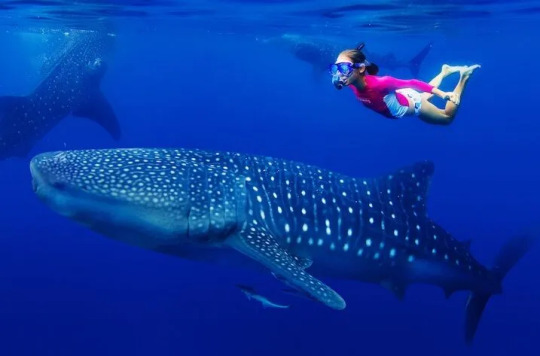
(Image: a person in a pink swimsuit wearing goggles and a snorkel swimming next to a whale shark just beneath the surface of the water. Two other whale sharks are in the background. End ID)
#wet beast wednesday#whale shark#shark#sharks#shark week#fish#fishblr#fishposting#carpet shark#marine biology#marine life#biology#ecology#zoology#animal facts#informative#educational#image described
164 notes
·
View notes